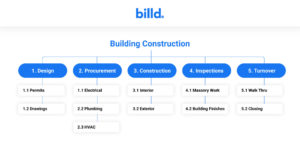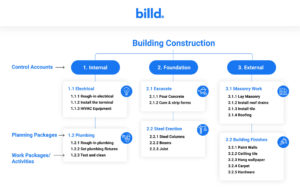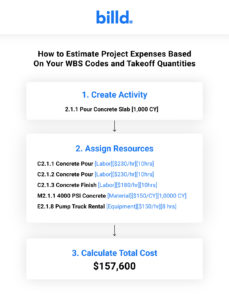Estimating project expenses requires a significant level of technical expertise, but perfecting an estimate is an art form. Here’s a guide on how to create top notch estimates for any project.
Table of Contents
1. Review and Assess The Project’s Scope
Before estimating your project expenses, it’s essential to understand your project’s scope. This goes beyond just reading the plans and specifications. You should also rely on your personal relationships with the project owners, architects, and engineers to verify any aspects of the project that are unclear or vague.
Conduct an in-depth review of your project’s contract documents, plans, and specifications to determine what work you will be performing. You also need to determine and make note of any bonding requirements, security clearances, reporting requirements, and inspection requirements along with any other project details that should be included as indirect costs in your estimate.
2. Create an Accurate Quantity Takeoff
Your construction estimate hinges on your quantity takeoff. Accuracy depends on an understanding of the construction plans, and the quantity of each construction activity that you’ll be performing.
You should use takeoff software to ensure your takeoff is as accurate as possible. As you take off different elements of your construction project, you should constantly double check your work. Below are some great takeoff softwares that you can use to eliminate errors in your takeoffs:
Once you start your takeoff, you should be systematic in your execution. Whether that means taking off each floor of a building or each type of activity at once is up to you, but make a plan and stick with it. If you’re doing a takeoff and not using a takeoff software that tracks your quantities make sure you’re recording your takeoff values in a spreadsheet.
3. Choose the Best Estimating Software
Before we talk about creating work breakdown structures for your estimates, it’s important to emphasize the importance of choosing the right estimating software for your construction business. While some estimates can be made in a spreadsheet, if you get over five construction activities, it is important to start looking into more advanced softwares.
Below are some great programs to look into for your business. You’ll notice that some of our estimating and takeoff softwares overlap. That’s because some include both estimating and takeoff capabilities in the same software. For example, if you’re looking for a software that has vast documentation sharing and automation capabilities, BlueBeam Revu may be what you’re looking for.
4. Create a Work Breakdown Structure
The Goal of a Work Breakdown Structure
The goal of a work breakdown structure (WBS) is to break work into smaller, more manageable tasks that can be estimated, tracked, and analyzed during the estimating, planning, and construction phases. We can’t stress enough the importance of having a work breakdown structure when putting together estimates. If your construction business doesn’t already have a work breakdown structure in place then this is the time to create one. Imagine having the ability to not only estimate a job, but also schedule it at the same time in hours or days, instead of weeks or months.
Breaking down a project into tasks enables you to estimate costs more accurately, assign tasks to crews and other companies, and analyze data in a way that enables you to improve efficiency, deliverability, and profitability.
Types of Work Breakdown Structures in Construction
The two most common types of work breakdown structures in construction are deliverable-based and phase-based. Both are very popular, but you should select the right type for your company.
Phase-Based: Breaks the project into the 5 construction phases: design, procurement, construction, testing and balancing, and closeout. This WBS is common for general contractors.

Deliverable-Based: Breaks the project down by deliverables to be completed and includes the work that will be executed for each deliverable.This WBS is very common for subcontractors.

Although these are the most common work breakdown structures, companies also make custom work breakdown structures all the time. Every project is different, every construction company is different, and every project manager is different. So make sure that your WBS aligns with whatever makes your project estimates and schedules more manageable.
Elements of a WBS
Creating a database within your estimating software that includes your WBS dictionary, WBS codes, and resources is the best way to create estimates quickly and efficiently.
- WBS Dictionary: Your company can make a WBS dictionary that defines all of your WBS elements including the deliverables, milestones, activities, and resources. Most WBS dictionaries follow the CSI Master Format structure and numbering system. This ends up being a database that you can use on all projects.
- WBS Codes: These are the alphanumeric codes you assign to your WBS dictionary elements. For each WBS code or element you can assign a certain quantifiable measurement (e.g. CY of concrete, LF of formwork, LF of rebar, SY of asphalt, SF of flooring).
- Activities/Work Packages: Refer to the activity occurring for a given WBS code. Should be the WBS code descriptor. These are also called work packages.
- Resources: Labor, materials and equipment are the three categories of resources. On any project you can fit any expense under these three categories. All resources have expenses assigned to them. Once your resources are uploaded they can be assigned to WBS codes (activities) in a process called resource allocation, or resource loading.
-
- Labor includes direct and indirect labor costs meaning hourly and salaried employees. Labor rates for hourly employees are quantified as an hourly rate (e.g. one laborer costs $19.50 per hour). Costs associated with salaried employee resources can be calculated as an hourly rate or a yearly rate with a percentage of cost allocation assigned to specific WBS codes.This cost should include all indirect costs, also called the employee labor burden which includes the “hidden” costs of keeping an employee, like benefits, sick pay, insurance, etc.
- Equipment includes all owned or rented equipment used on a job. Depreciation, rental fees, mechanic fees, and any other costs you have associated with a piece of equipment should be included within an hourly rate.
- Material includes materials that are installed on a project as well as materials that are only used during the construction process. We all know that construction material price models are complex and prices are volatile. Some estimating softwares will allow you to upload live databases of material prices like RSMeans data, which will give you live updates of material prices taken from different data sources. That being said the safest way to estimate material costs is going to be to use updated quotes from your material suppliers. Don’t forget to also include any additional indirect material costs like material financing.
The reason for creating a WBS dictionary and assigning costs to resources is so that you can assign a number of units of a certain resource (e.g. one foreman, three equipment operators, two laborers, two excavators, and one bulldozer) to your WBS codes. Each WBS code will have assigned resources, with utilization rates, labor rates, material costs, and equipment costs. See the example below for a visual depiction.

How to Estimate Project Expenses Based On Your WBS Codes and Takeoff Quantities
This is where all your hard work comes together. All the effort put into creating your WBS dictionary and codes are about to save you an enormous amount of time. Now you simply plug in your takeoff quantities and your WBS codes with assigned resources and your costs per WBS code will automatically be calculated.
Then you can add your profit margins by entering a percentage of the overall project and your estimating software will automatically calculate your profit. Want different profit margins for different WBS codes (construction activities)? Estimating softwares will allow you to assign different profit margins to different construction activities that you include in your estimate.
Verifying the Type of Construction
Every state has different sales tax laws for different types of construction projects. Knowing what type of construction you will be performing in the eyes of the state makes a huge impact on your profit margins and the competitive edge of your bid.
For example: Many states give sales tax exemption on materials purchased for public construction projects and remodeling/refurbishment projects.
Knowing your state’s sales tax laws will not only help you cut the cost of your estimates and deliver greater value to your customers, it also makes your estimate more competitive. Once you know your state’s tax laws you can add them into your estimating program so it automatically changes the costs of your resources in your estimate based on the type of construction you are performing.
Putting Together Your Final Estimate
Your final estimate will be a culmination of your assessment of the project’s scope, takeoff, work breakdown structure, material costs, indirect costs, and the project’s tax exemption status. This will be a 1-5 page breakdown that includes all the aspects of your estimate. Depending on the final deliverable your estimate may need to be formatted in different ways.
For example a general contractor may just want a lump sum estimate, or they could want an estimate broken down by installation quantities (e.g. install 5,000 SF of flooring), or broken down by crew and equipment rates (e.g. pump truck rental per hour costs $150). The type of final estimate that you produce will depend on your clients, but the estimating process should stay the same. Most estimating programs will also allow you to automatically convert your estimates into different formats like the examples listed above.
Now you should be ready to estimate your project expenses in record time!











